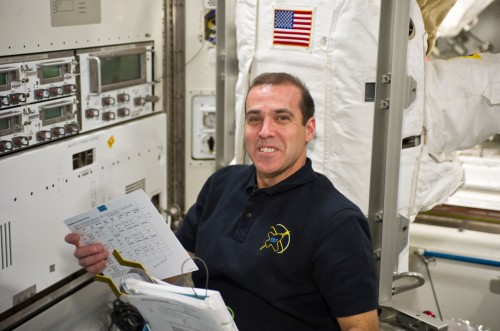 RICHARD MASTRACCHIO ’87 ON the International Space Station did a Q&A session on Friday for students from his alma maters.
RICHARD MASTRACCHIO ’87 ON the International Space Station did a Q&A session on Friday for students from his alma maters.On Friday, April 18, Richard Mastracchio ’87 was featured on the large screen in the Experimental Media and Performing Arts Center while he answered questions from students. This all was done while he was freely floating, for he was speaking from outside of our world. Mastracchio is currently stationed on the International Space Station which hangs in low-earth orbit 250 miles above our heads.
Mastracchio graced the school with his presence in cooperation with NASA through a program which allowed a brief question and answer session between his three alma maters: the University of Connecticut, University of Houston Clear Lake, and Rensselaer. While the time had to be split up between these three academies, each was able to ask six to seven questions about Mastracchio’s life and work while away from the planet. RPI’s inquisitive students consisted of graduate student Alexander Angilella ’13, president of the Rensselaer chapter of the American Institute of Aeronautics and Astronautics, Emily Frantz ’15, president of RPI’s chapter for SWE, Kassandra Morales ’15, ROTC member, and Evan Kaiser ’15, Ryan Moriarty ’16, and Christopher Volk ’14, past NASA interns.
When Morales asked about the most surprising result of space travel, Mastracchio stated that the potential future applications of the journey is what excited him most. With the involvement of SpaceX and the Orbital Sciences Corporation, the commercial possibilities for further low orbit residences are expanding. Vehicles and inflatable residences are currently being researched by private companies and with the success of the ISS, Mastracchio is hopeful that these technologies will soon appear in the public eye.
Moriarty inquired to the success of the Soyuz rockets to the previously used rockets that were used for space shuttle launches. This question was in light of the Soyuz rocket’s current use as the primary transportation for astronauts up to the ISS today. Mastracchio compared the two shuttle’s immediately noticeable acceleration straight from the launch pad in contrast to the Soyuz’s less perceptible speed increase. However, he did state that he would ride either again.
Through the questions asked by the remaining schools, the audience learned a lot about Mastracchio, his life on the ISS, and about the structure of the ISS, itself. To future astro-hopefuls, he recommends centering one’s education and progress through life around a passion. While he acknowledges this a worthy overall life motto, he also states that his job was gained through his love of electrical engineering. A student from the University of Houston asked about Mastracchio’s relationship with his fellow and foreign crewmates, to which the alumnus reported excellent relations. Because of the closeness of their quarters and interpersonal relationships, he says that political, ethnic, and even linguistic boundaries are worked around with ease. He credits this to their common interests in science, the actual closeness of their workspace, and not to mention the seriousness of their overall mission.
The ISS has been in space since 1998 when its first segment, Zarya, was launched by Russia. The station has been constantly occupied since 2000 and now contains crew from the U.S., Russia, and Japan. Dean of the School of Science Laurie A. Leshin reports that the station is roughly the size of a six-bedroom apartment, and that there is an application available for most mobile phones that tracks the movement of the station so that it may be seen on the ground by the user. More information about the ISS can be found at NASA’s site, http://poly.rpi.edu/08077.
